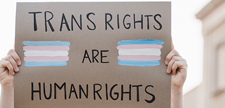
For far too long disparities in the health care system, whether it was race, socioeconomic class or gender identity, have had a major impact on patients. Today we still see disproportionate measures when it comes to cancer and how it is diagnosed and treated. Breast cancer is the most common non-cutaneous cancer, with hundreds of thousands of new cases each year. Due to the increase in early detection and more effective treatments, the overall mortality rate due to breast cancer has decreased over the years.

Helen Brooke Taussig, MD, was a visionary physician who is considered the founder of pediatric cardiology. Born in 1898, she would go on to have a prolific career in medicine at a time when few women were afforded the opportunity.

It seems that almost every woman in every medical field has an anecdote about being mistaken For another member of the health care team, or about having their medical decision-making undermined by either a patient or a colleague. As a medical student with only a little over a year of clinical experience under my belt, I too have these stories.

Being a woman in medicine means different things to different people. For some, it means finding their own niche in a historically male-dominated field. For others, it means providing comfort and care to other women in their most desperate times of need. For most, it means being able to inspire future generations to pursue whatever they dream of, free of the shackles of labels, discouragement and doubt.

Rising temperatures, sinking cities and increased natural disasters show the necessity of addressing climate change today. While these issues have sparked a global uproar and propelled action among world leaders, an insidious component of climate change lurks beneath the surface of melting ice and raging fires. Climate change highlights inequality and demonstrates the vulnerability of certain regions and populations.

The 20th century marked an era where there was a substantial increase in the number of women entering the medical field and the number of female physicians making significant contributions to society. One such physician was Patricia Bath, MD, an innovative ophthalmologist, and scientist who invented laser cataract surgery.

Gender identity is often fluid, and individuals who identify as transmasculine can still have the desire to chestfeed and carry their own child in their uteruses. Birthing parents who do not identify as a woman exist and they may not resonate with terms like "breastfeeding" or "mom." Language is powerful, as it can cause harm people and trigger feelings of gender dysphoria. But on the other hand, it can empower and help people feel more included.

Medical and technological advancements over the last century have resulted in substantial improvements in health for people of all genders in the United States. However, Black women continue to have poorer health outcomes and higher mortality rates than other U.S. women. According to Black Demographics, despite being younger (36.1 years) on average than U.S. women overall (39.6 years), Black women have a higher prevalence of acute and chronic health conditions, including heart disease, stroke, cancer, diabetes, obesity, stress and pregnancy-related morbidity (Chinn et al. 2021).

Amidst anti-transgender legislation and don’t-say-gay bans, it is vital to consider the social and public health implications of attempts to minimize or even eliminate the experience of gender and sexual minorities. Transgender, or trans, individuals are those whose gender expression or identity differs from what they were assigned at birth.

We are a grassroots advocacy organization of medical students across the country, focused on making health care more equitable for patients in larger bodies. We join the physicians, eating disorder professionals, and community members who raise concerns regarding the AAP’s most recent clinical guidelines, “Clinical Practice Guideline for the Evaluation and Treatment of Children and Adolescents with Obesity.” (kevinmd.com)

-->
In cardiology, women comprise only 18% of fellows, less than 15% of practicing general cardiologists, and less than 5% of interventional cardiologists. This is a stark difference to the patients they serve, with recent estimates indicating that more than 50% of women in the United States above 40 years old suffer from cardiovascular disease.

Cancer screening guidelines have largely contributed to reduced cancer mortality in recent medicine. Mammograms, colonoscopies and Pap smears have aided in early detection and treatment. However, the guidelines set by the United States Preventative Services Task Force and American Cancer Society are limited to cisgender individuals. There are not currently any clear guidelines about cancer screening in transgender individuals.